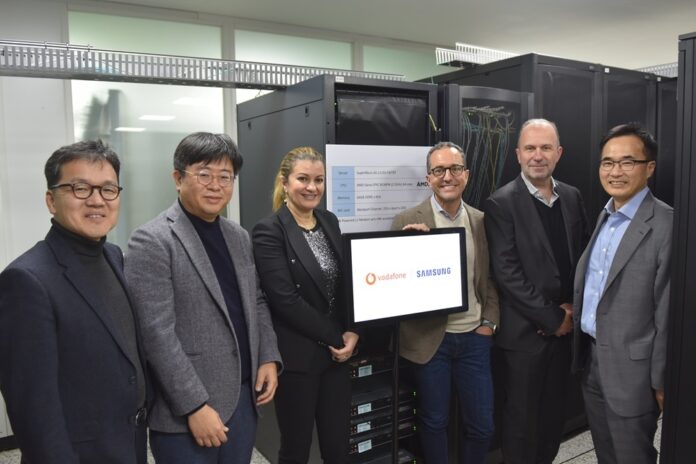Achieved results “exceeding 1Gbps” for multiple devices on a multi-cell configuration and will demo this at MWC Barcelona
Vodafone and Samsung Electronics and AMD successfully demonstrated an end-to-end call with the latest AMD processors enabling Open RAN technology. Conducted in Samsung’s R&D lab in South Korea, the first call was completed using Samsung’s O-RAN-compliant, virtualized RAN (vRAN) software, powered by AMD EPYC 8004 Series processors on Supermicro’s Telco/Edge servers, supported by Wind River Studio Container-as-a-Service (CaaS) platform.
The demonstration aimed to verify optimised performance, energy efficiency and interoperability among partners’ solutions. The choice of AMD will have key Open RAN silicon manufacturer Intel looking over its shoulder but from an operator standpoint, it is demonstrating just how important telecom-specific chips are becoming to the industry. This week Telstra and Ericsson deployed high-density Genoa microprocessors from AMD for Ericsson’s bare metal cloud environment in the operator’s 5G core. AI silicon leader Nvidia has also woken up to the fact that specialised chips are going to become a fast-growing industry segment as its rumoured collaboration with Ericsson has shown.
“Open RAN represents the forthcoming major transformation in advancing mobile networks for the future,” said Vodafone Group network strategy and engineering director Nadia Benabdallah. “Reaching this milestone with top industry partners like Samsung and AMD shows Vodafone’s dedication to delivering on the promise of Open RAN innovation.”
She added that the broader and growing Open RAN ecosystem helps operators to build and modernise mobile networks with greater flexibility, faster time-to-market and better performance.
“This collective effort marks a key milestone for the mobile network industry to steer Open RAN forward, by embracing multiple providers at every layer of the network stack,” said Samsung EVP & head of R&D, Networks Business June Moon. “The demo illustrates Samsung’s commitment to delivering the full potential of mobile networks by embracing openness.”
“The telco industry continues to demand new levels of performance and energy efficiency with increasingly complex workloads and stringent efficiency targets,” said AMD corporate vice president, strategic market development Kumaran Siva. “AMD EPYC 8004 Series CPUs are optimizsed for modern edge and vRAN deployment models to enable the telco industry’s current evolution toward truly end-to-end open, virtualised networks.”
Samsung looking good
If the UK market is an indication of what it is to come, Samsung could do well out of the tender. It has provided RAN software and radios in the limited UK deployment. It could well be that Vodafone opts for centralised approach to leverage scale, control and replicable integration and processes.
In June 2021, Samsung became a strategic partner for Vodafone to carry out its Open RAN vision. Since then, the companies have been expanding their collaboration, recently marking a milestone of kicking off the largest Open RAN rollout in the UK in August 2023. Samsung announced a new collaboration with AMD as well to advance 5G vRAN and virtualized Open RAN for network transformation.
Last week, Vodafone Group’s CEO, Margherita Della Valle, said the operator will start the tender for 170,000 Open RAN sites it announced last October. Vodafone Group’s largest stakeholder and business partner, e&, will be involved in procurement. Whether or not Vodafone opts for a single, dual or multiple supplier(s) remains to be seen. However, Samsung stands to gain in the tender having already provided RAN software and radios in Vodafone’s limited Open RAN UK deployment.
Samsung is also at the heart of Verizon’s plan to deploy more than 130,000 Open-RAN ready radios. These include massive MIMO radios which are part of the 15,000 Open RAN-compliant virtualised cell sites announced last September. These sites have O-RAN compliant baseband units. The US operator began implementing Samsung’s virtual RAN (vRAN) equipment several years ago as part of its roadmap to Open RAN. Verizon has said it intends to have deployed vRAN equipment at 20,000 sites by 2025.
Samsung said that with its goal of pre-testing and integrating, the company has sought to validate its vRAN and Open RAN solutions to offer network operators an efficient path to market. The three companies in the trial will demonstrate its test result exceeding 1Gbps throughput for multi-UE on multi-cell configuration at MWC 2024.
Pictured, from left, Junehee Lee (Samsung Electronics), June Moon (Samsung Electronics), Nadia Benabdallah (Vodafone Group), Yago Tenorio (Vodafone Group), Alberto Ripepi (Vodafone Group), Woojune Kim (Samsung Electronics)


